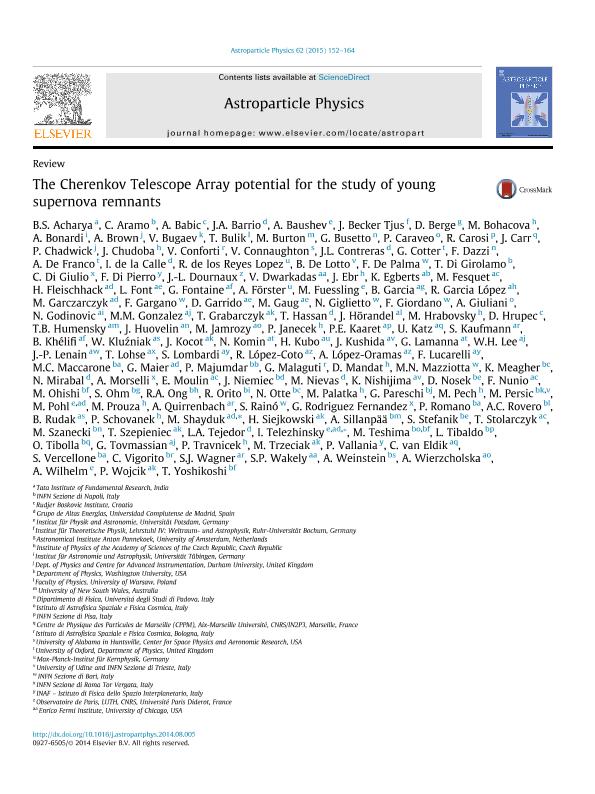Mostrar el registro sencillo del ítem
dc.contributor.author
Acharya, B. S.
dc.contributor.author
Aramo, C.
dc.contributor.author
Babic, A.
dc.contributor.author
Barrio, J. A.
dc.contributor.author
Baushev, A.
dc.contributor.author
Becker Tjus, J.
dc.contributor.author
Berge, D.
dc.contributor.author
Bohacova, M.
dc.contributor.author
Bonardi, A.
dc.contributor.author
Brown, A.
dc.contributor.author
Bugaev, V.
dc.contributor.author
Bulik, T.
dc.contributor.author
Burton, M.
dc.contributor.author
Busetto, G.
dc.contributor.author
Caraveo, P.
dc.contributor.author
Carosi, R.
dc.contributor.author
Carr, J.
dc.contributor.author
Chadwick, P.
dc.contributor.author
Chudoba, J.
dc.contributor.author
Conforti, V.
dc.contributor.author
Connaughton, V.
dc.contributor.author
Contreras, J. L.
dc.contributor.author
Cotter, G.
dc.contributor.author
Dazzi, F.
dc.contributor.author
De Franco, A.
dc.contributor.author
de la Calle, I.
dc.contributor.author
de los Reyes Lopez, R.
dc.contributor.author
De Lotto, B.
dc.contributor.author
Garcia, Beatriz Elena

dc.contributor.author
Rovero, Adrian Carlos

dc.contributor.author
The Cta Consortium
dc.date.available
2017-06-06T18:01:15Z
dc.date.issued
2015-03
dc.identifier.citation
Acharya, B. S.; Aramo, C.; Babic, A.; Barrio, J. A.; Baushev, A.; et al.; The Cherenkov Telescope Array potential for the study of young supernova remnants; Elsevier Science; Astroparticle Physics; 62; 3-2015; 152-164
dc.identifier.issn
0927-6505
dc.identifier.uri
http://hdl.handle.net/11336/17573
dc.description.abstract
Supernova remnants (SNRs) are among the most important targets for γ-ray observatories. Being prominent non-thermal sources, they are very likely responsible for the acceleration of the bulk of Galactic cosmic rays (CRs). To firmly establish the SNR paradigm for the origin of cosmic rays, it should be confirmed that protons are indeed accelerated in, and released from, SNRs with the appropriate flux and spectrum. This can be done by detailed theoretical models which account for microphysics of acceleration and various radiation processes of hadrons and leptons. The current generation of Cherenkov telescopes has insufficient sensitivity to constrain theoretical models. A new facility, the Cherenkov Telescope Array (CTA), will have superior capabilities and may finally resolve this long standing issue of high-energy astrophysics. We want to assess the capabilities of CTA to reveal the physics of various types of SNRs in the initial 2000 years of their evolution. During this time, the efficiency to accelerate cosmic rays is highest. We perform time-dependent simulations of the hydrodynamics, the magnetic fields, the cosmic-ray acceleration, and the non-thermal emission for type Ia, Ic and IIP SNRs. We calculate the CTA response to the γ-ray emission from these SNRs for various ages and distances, and we perform a realistic analysis of the simulated data. We derive distance limits for the detectability and resolvability of these SNR types at several ages. We test the ability of CTA to reconstruct their morphological and spectral parameters as a function of their distance. Finally, we estimate how well CTA data will constrain the theoretical models.
dc.format
application/pdf
dc.language.iso
eng
dc.publisher
Elsevier Science

dc.rights
info:eu-repo/semantics/openAccess
dc.rights.uri
https://creativecommons.org/licenses/by-nc-nd/2.5/ar/
dc.subject
Acceleration of Particles
dc.subject
Gamma Rays
dc.subject
Supernova Remnants
dc.subject.classification
Astronomía

dc.subject.classification
Ciencias Físicas

dc.subject.classification
CIENCIAS NATURALES Y EXACTAS

dc.title
The Cherenkov Telescope Array potential for the study of young supernova remnants
dc.type
info:eu-repo/semantics/article
dc.type
info:ar-repo/semantics/artículo
dc.type
info:eu-repo/semantics/publishedVersion
dc.date.updated
2017-06-01T16:45:46Z
dc.journal.volume
62
dc.journal.pagination
152-164
dc.journal.pais
Países Bajos

dc.journal.ciudad
Amsterdam
dc.description.fil
Fil: Acharya, B. S.. Tata Institute of Fundamental Research; India
dc.description.fil
Fil: Aramo, C.. INFN; Italia
dc.description.fil
Fil: Babic, A.. Rudjer Boskovic Institute; Croacia
dc.description.fil
Fil: Barrio, J. A.. Universidad Complutense de Madrid; España
dc.description.fil
Fil: Baushev, A.. Universität Potsdam; Alemania
dc.description.fil
Fil: Becker Tjus, J.. Ruhr-universität Bochum; Alemania
dc.description.fil
Fil: Berge, D.. University of Amsterdam; Países Bajos
dc.description.fil
Fil: Bohacova, M.. Institute of Physics of the Academy of Sciences of the Czech Republic; República Checa
dc.description.fil
Fil: Bonardi, A.. Universität Tübingen; Alemania
dc.description.fil
Fil: Brown, A.. Durham University; Reino Unido
dc.description.fil
Fil: Bugaev, V.. Washington University; Estados Unidos
dc.description.fil
Fil: Bulik, T.. University of Warsaw; Polonia
dc.description.fil
Fil: Burton, M.. University Of New South Wales; Australia
dc.description.fil
Fil: Busetto, G.. Universitá degli Studi di Padova; Italia
dc.description.fil
Fil: Caraveo, P.. Istituto di Astrofisica Spaziale e Fisica Cosmica; Italia
dc.description.fil
Fil: Carosi, R.. INFN; Italia
dc.description.fil
Fil: Carr, J.. Aix-Marseille Université; Francia
dc.description.fil
Fil: Chadwick, P.. Durham University; Reino Unido
dc.description.fil
Fil: Chudoba, J.. Institute of Physics of the Academy of Sciences of the Czech Republic; República Checa
dc.description.fil
Fil: Conforti, V.. Istituto di Astrofisica Spaziale e Fisica Cosmica; Italia
dc.description.fil
Fil: Connaughton, V.. University of Alabama; Estados Unidos
dc.description.fil
Fil: Contreras, J. L.. Universidad Complutense de Madrid; España
dc.description.fil
Fil: Cotter, G.. University of Oxford; Reino Unido
dc.description.fil
Fil: Dazzi, F.. Universitá degli Studi di Padova; Italia
dc.description.fil
Fil: De Franco, A.. t University of Oxford; Reino Unido
dc.description.fil
Fil: de la Calle, I.. Universidad Complutense de Madrid; España
dc.description.fil
Fil: de los Reyes Lopez, R.. Max-Planck-Institut für Kernphysik; Alemania
dc.description.fil
Fil: De Lotto, B.. University of Udine; Italia
dc.description.fil
Fil: Garcia, Beatriz Elena. Consejo Nacional de Investigaciones Científicas y Técnicas. Oficina de Coordinación Administrativa Parque Centenario. Instituto de Tecnologías en Detección y Astropartículas. Subsede del Instituto de Tecnologías en Detección y Astropartículas Mendoza; Argentina
dc.description.fil
Fil: Rovero, Adrian Carlos. Consejo Nacional de Investigaciónes Científicas y Técnicas. Oficina de Coordinación Administrativa Ciudad Universitaria. Instituto de Astronomía y Física del Espacio. - Universidad de Buenos Aires. Facultad de Ciencias Exactas y Naturales. Instituto de Astronomía y Física del Espacio; Argentina
dc.description.fil
Fil: The Cta Consortium.
dc.journal.title
Astroparticle Physics

dc.relation.alternativeid
info:eu-repo/semantics/altIdentifier/doi/http://dx.doi.org/10.1016/j.astropartphys.2014.08.005
dc.relation.alternativeid
info:eu-repo/semantics/altIdentifier/url/http://www.sciencedirect.com/science/article/pii/S0927650514001297
Archivos asociados
